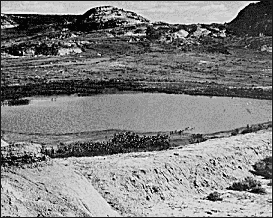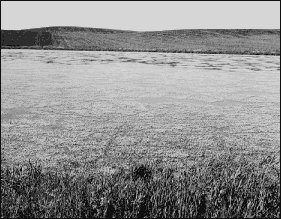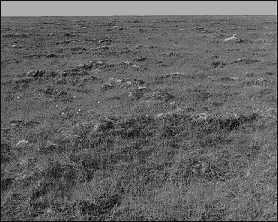
 |
| Plate 53.--Classification: SYSTEM Palustrine, CLASS Unconsolidsted Bottom, SUBCLASS Mud, WATER REGIME Semipermanently Flooded, WATER CHEMISTRY Flesh-Alkaline, SOIL Mineral, SPECIAL MODIFIER Impounded. A sparse stand of water plantain (Alisma plantago-aquatica) appears along the edge of the impoundment. (Billings County, North Dakota; July 1970; Photo by J. T. Lokemoen) |
 |
| Plate 54.--Classification: SYSTEM Palustrine, CLASS Aquatic Bed, SUBCLASS Rooted Vascular, DOMINANCE TYPE Ranunculus trichophyllus, WATER REGIME Semipermanently Flooded, WATER CHEMISTRY Oligosaline, SOIL Mineral. (Stutsman County, North Dakota; August 1966; Photo by R.E. Stewart) |
 |
| Plate 55.--Classification: SYSTEM Palustrine, CLASS Moss-Lichen Wetland, SUBCLASS Moss, WATER REGIME Saturated, WATER CHEMISTRY Flesh-Acid, SOIL Organic. The dominant plant is peat moss (Sphagnum spp.). Subordinate plants include reindeer moss (Cladina spp.), leatherleaf (Chamaedaphne calyculata), crowberry (Empetrum nigrum), and cottongrass (Eriophorum spp.).(Campobello Island International Park, Maine-Canada; June 1976; Photo by V. Carter) |
 |
| Plate 56.--Classification: SYSTEM Palustrine, CLASS Moss-Lichen Wetland, SUBCLASS Moss, WATER REGIME Saturated, WATER CHEMISTRY Fresh. Peat moss (Sphagnum spp.) is the dominant plant. Subordinate plants include sedges (Carex rariflora, C. aquatilis), cottongrass (Eriophorum russeolum), and reindeer moss (Cladina spp.). While sedges are present, their combined cover is less than 30%. Mosses cover 100% of the area. (Narokachik-Azun Rivers area, Yukon-Kuskokwim Delta, Alaska; July 1985; Photo by F. C. Golet) |